
Suzuki Motor Corporation is a Japanese multinational mobility manufacturer headquartered in Hamamatsu, Shizuoka. It manufactures automobiles, motorcycles, all-terrain vehicles (ATVs), outboard marine engines, wheelchairs and a variety of other small internal combustion engines. In 2016, Suzuki was the eleventh biggest automaker by production worldwide. Suzuki has over 45,000 employees and has 35 production facilities in 23 countries, and 133 distributors in 192 countries. The worldwide sales volume of automobiles is the world's tenth largest, while domestic sales volume is the third largest in the country.

The Chevrolet Cavalier is a line of compact cars produced by Chevrolet. Serving as the replacement of the Chevrolet Monza, the Cavalier was the second Chevrolet model line to adopt front-wheel drive. Three versions of the Cavalier have been sold, including three generations sold in North America sold from the 1982 to 2005 model years, a version produced by SAIC-GM for China from 2016 to 2021, and a SAIC-GM version produced for Mexico since the 2019 model year.

The Toyota Starlet is a subcompact car manufactured by Toyota from 1973 until 1999, replacing the Publica, but retaining the Publica's "P" code and generation numbering. The first generation Starlet was sold as the Publica Starlet in some markets. In Japan, it was exclusive to Toyota Corolla Store dealers.
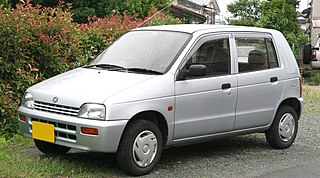
The Suzuki Alto is a kei car produced by Suzuki since 1979. The model, currently in its ninth generation, was first introduced in 1979 and has been built in many countries worldwide. The Alto originated as a commercial vehicle derivative of the Fronte, but over time the Alto nameplate gained in popularity and by 1988 it replaced the Fronte name completely. The Alto badge has often been used on different cars in Japan and in export markets, where it is considered a city car.
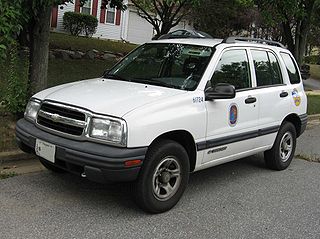
The Chevrolet Tracker, formerly the Geo Tracker, is a mini SUV produced for Chevrolet and Geo by CAMI Automotive in Ingersoll, Ontario. Although appearing as a compact SUV, the Tracker was actually certified as a light truck due to its off-road capabilities and body on frame construction. The Tracker was produced under many brands in several different editions and in many countries.

The Suzuki Aerio is a subcompact car that was built by Suzuki. It was introduced in 2001 as a replacement for the Suzuki Esteem/Baleno, with a tall 5-door SX model hatchback and a 4-door sedan body. It featured two different 16-valve gasoline inline-four engines, with 1.5-litre and 1.8-litre, this one capable of 125 PS JIS. Production was discontinued in 2007 around the world and replaced by the Suzuki SX4, except in Pakistan and China where production was continued by Changhe-Suzuki until 2019.

The Suzuki Cappuccino is a sports car produced by the Japanese company Suzuki from 1991 to 1998. It is a two-seater roadster with a detachable hardtop that is designed to meet Japanese kei car regulations.

A compact sport utility vehicle or compact SUV is a class of small sport utility vehicles that is larger than mini SUVs, but smaller than mid-size SUVs. However, there is no official definition of the size or dimensions for this market segment. Moreover, some manufacturers have marketed the same model name on different sized vehicles over time. The most common distinction between versions of crossover automobiles and compact-sized SUVs is that the first is based on a car-based unibody platform, while an SUV uses the unibody with welded-in ladder frame or body-on-frame chassis commonly used on trucks. However, manufacturers and common usage has blurred the two terms. Many recent vehicles labelled as compact SUVs are technically compact crossovers and are built on the platform of a compact/C-segment passenger car, while some models may be based on a mid-size car (D-segment) or a B-segment platform.

The Suzuki Cultus is a supermini car produced by the Japanese manufacturer Suzuki from 1983 to 2016. The nameplate is currently used as a rebadged second-generation Suzuki Celerio in Pakistan since 2017. It was first presented at the 25th Tokyo Motor Show, formally introduced to Japan in 1983 and ultimately sold in seven countries across three generations and marketed worldwide as the Suzuki Swift for the first two generations. An alliance formed in 1981 between General Motors, Suzuki and Isuzu allowed GM to market the Cultus as a captive import internationally under more than a dozen nameplates including the Geo Metro, Chevrolet Sprint, Pontiac Firefly and Holden Barina. It was also known as the M-car within GM.

The Suzuki Vitara is a series of SUVs produced by Suzuki in five generations since 1988. The second and third generation were known as the Suzuki Grand Vitara, while the fourth generation eschewing the "Grand" prefix. In Japan and a number of other markets, all generations have used the name Suzuki Escudo.

The Mercedes-Benz W210 was the internal designation for a range of executive cars manufactured by Mercedes-Benz and marketed under the E-Class model name in both sedan/saloon (1995–2002) and station wagon/estate (1996–2003) configurations. W210 development started in 1988, three years after the W124's introduction.
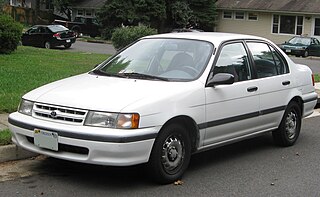
The Toyota Tercel is a subcompact car manufactured by Toyota from 1978 until 1999 across five generations, in five body configurations sized between the Corolla and the Starlet. Manufactured at the Takaoka plant in Toyota City, Japan, and sharing its platform with the Cynos and the Starlet, the Tercel was marketed variously as the Toyota Corolla II — sold at Toyota Japanese dealerships called Toyota Corolla Stores — and was replaced by the Platz in 1999. It was also known as the Toyota Corsa and sold at Toyopet Store locations. Starting with the second generation, the Tercel dealership network was changed to Vista Store, as its badge engineered sibling, the Corolla II, was exclusive to Corolla Store locations.
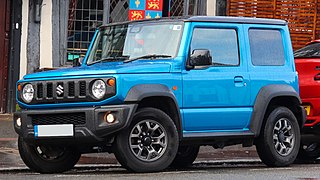
The Suzuki Jimny is a series of four-wheel drive off-road mini SUVs, manufactured and marketed by Japanese automaker Suzuki since 1970.

The Suzuki SX4 is a subcompact car and crossover produced by Japanese automaker Suzuki since 2006. A successor of the Aerio tall hatchback and sedan, the first-generation model was available as a hatchback and sedan, with the former available in both front- and four-wheel drive and as a rebadged version in Europe called the Fiat Sedici.
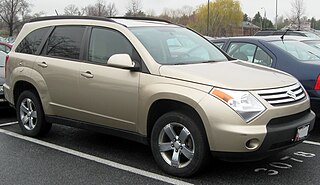
The Suzuki XL-7 is a mid-size SUV sold by Suzuki from 1998 to 2009, over two generations. Slotted above the Grand Vitara in Suzuki's lineup, the XL-7 offered three-row seating. XL-7 stands for "Xtra Large 7-seater".

The Toyota Ist is a subcompact car manufactured by the Japanese automaker Toyota. It is exported to the United States as the Scion xA and Scion xD, the Middle East as the Toyota xA and to Europe and Latin America as the Toyota Urban Cruiser for the second generation.

The Mitsubishi Delica is a range of vans and pickup trucks designed and built by the Japanese automaker Mitsubishi Motors since 1968. It was originally based on a cabover van and pickup truck introduced the previous year, also called the Delica, its name a contraction of the English language phrase Delivery car. This pickup truck, and a commercial van derived from it has received many names in export markets, being sold as the L300 in Europe, Jamaica and New Zealand, Express and Starwagon in Australia, and plain Mitsubishi Van and Wagon in the United States. The passenger car versions were known as Delica Star Wagon from 1979 until the 1994 introduction of the Delica Space Gear, which became simply Space Gear in Europe at least. The most recent version is called the Delica D:5. With the exception of the first, versions of all generations are still being sold in various international markets.

The Mitsubishi RVR is a range of cars produced by Japanese manufacturer Mitsubishi Motors from 1991 to 2002 and then from 2010 until present. The first two generations were classified as compact multi-purpose vehicles (MPV), and the model introduced in 2010 is a subcompact crossover SUV.

The Suzuki MR Wagon is a 4-seater kei car manufactured by Suzuki for the Japanese market only, and also marketed in Japan by Nissan as the Nissan Moco under an OEM agreement. The model debuted in 2001, and since 2011 it has been in its third generation. The first generation was also produced and sold in India by Maruti Suzuki as Maruti Zen Estilo, which was launched in 2006, Maruti Zen Estilo was discontinued in 2009 and renamed as Maruti Estilo.

The Suzuki Brezza is a subcompact crossover SUV from Suzuki and manufactured by Maruti Suzuki in India. The Brezza is the first Suzuki-branded car which was fully developed in India. The model was designed as a smaller alternative to the global market Vitara and targeted to young audiences. It is only available for right-hand drive emerging markets in Asia and Africa. The first-generation model was also marketed by Toyota as the Toyota Urban Cruiser between 2020 and 2022.




















